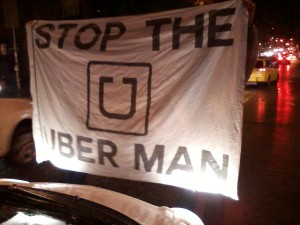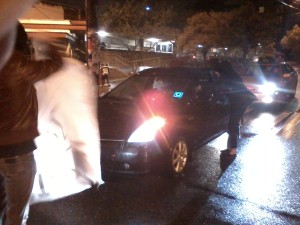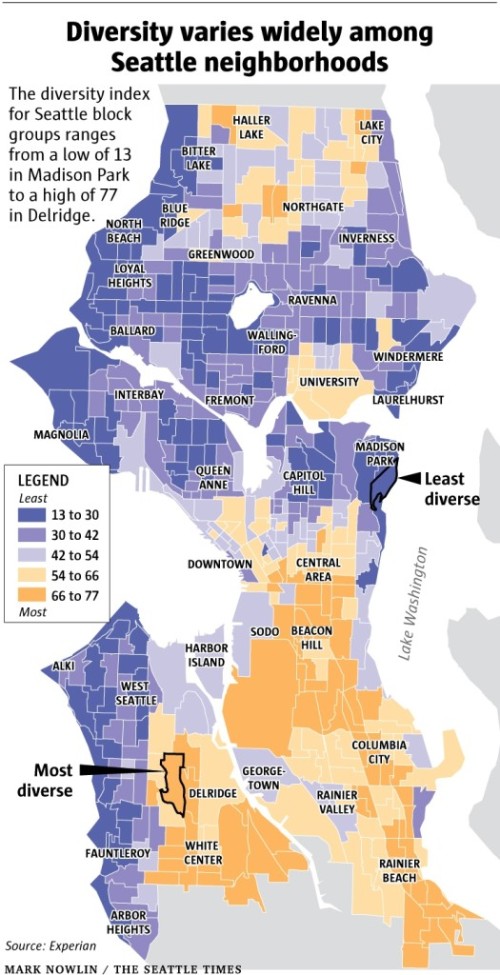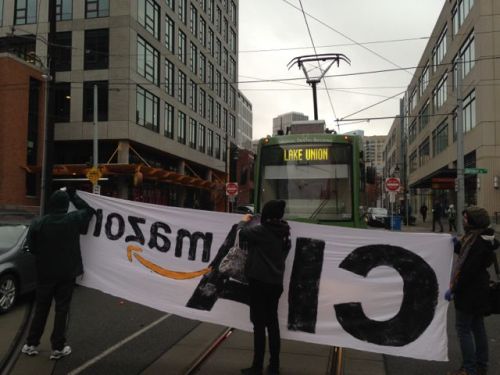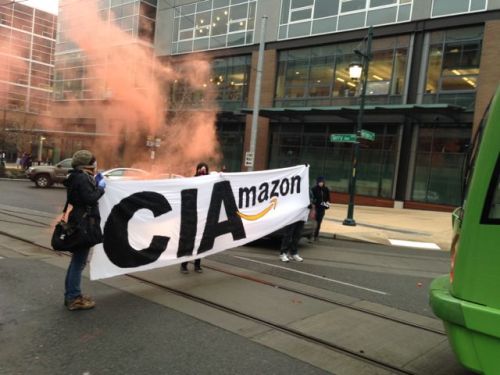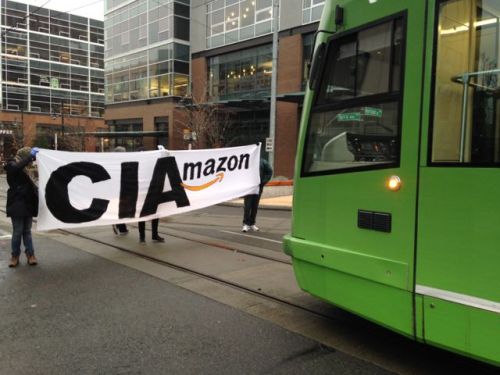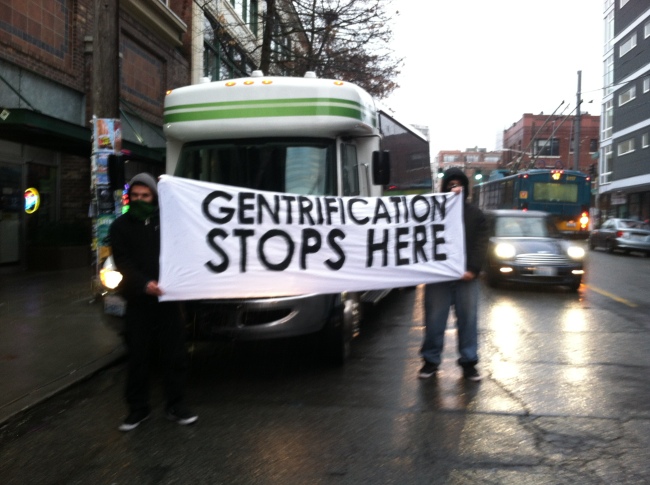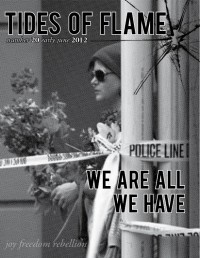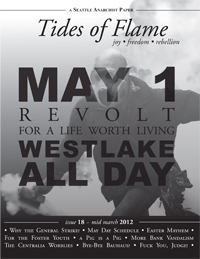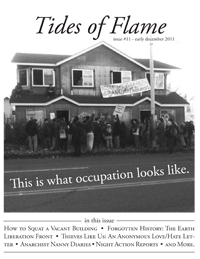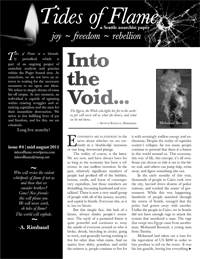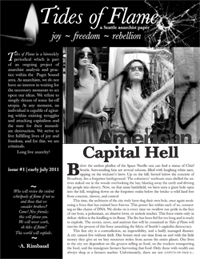(Although this article is nearly 4 years old, we repost it for future reference. Most of it is still applicable and relevant to the current situation.)

TACOMA – Trudging up 11th street from the bus stop one cold and soggy fall evening, my friend and I were stopped by an older homeless woman who had just been denied a bed in a shelter. She asked us if we knew of another place she could go for the night, and my friend remembered that his old house was still sitting vacant after his former roommates had been unceremoniously evicted almost a year before. We knew that the house was accessible through a backdoor and had been previously squatted with success, so my friend gave the woman the house’s address, and we parted ways.
A few days later, shuffling back down the hill to the transit center, I noticed that some new artwork had been installed in the Woolworths building’s Broadway windows. I stopped to look at the warmly pieces hanging silently in their sterile display case. It was very quiet on the street—dead quiet—just me and the artwork. Generally unimpressed, I continued on my way, only to encounter another of these ghostly galleries at the corner of 11th and Commerce. Here was an interactive video-installation piece. Two small tables were set against the windows, one piled with fake fruit and glass orbs, another with doll heads, wig forms, and masks. Two cameras angled at the viewer from behind each still-life composition, the lens-views obscured and warped by the objects on the tables. Screens displayed what the cameras recorded.
I had noticed these peculiar storefront displays in the past, once gawking through painted windows at the mysterious interior of the “Jesus-4-Less!” shop across from the Broadway Center for the Performing Arts. It couldn’t be a real shop, I thought at the time—could it? Then I noticed a logo on the glass— “SpaceWorks Tacoma”—and realized that it must have been some sort of art project.
Looking around at other signs of what yuppies call “urban revitalization”, I had a feeling I knew exactly what was going on. Here were new sidewalks and a busy Tully’s Coffee. I’d been hearing a lot about the changes happening in downtown Tacoma from friends who had grown up here or who had lived in Tacoma for a while. This “SpaceWorks” thing reeked of the art-fueled gentrification that I knew was happening in cities all over the world, from the newly muralled slums of 2016 Olympics host city Rio de Janiero, Brazil, all the way to Hamburg, Germany.
Out with the Old, In With the Nouveau Riche
Gentrification describes the process in which waves of wealthier people move into a neighborhood, usually displacing the poorer current residents. Race is an important factor in many gentrification processes, with the newcomers being mostly white, and the current residents, people of color. In all instances, the gentrifiers’ relative wealth allows them to buy and rent their way into poor neighborhoods which have suddenly become desirable due to their proximity to urban business and cultural centers. Landlords are eager to raise rents or sell their properties, often evicting old tenants, and current owner-occupiers are sometimes forced to move due to increased property taxes and pressures from zoning and code enforcement agencies.
Gentrifiers sometimes come on the coattails of young bohemian populations—mostly artists, musicians, and students, but sometimes even punks squatting vacant buildings. They seek to escape from humdrum suburbia into the authentic urban “village” they’ve seen in so many romantic comedies. And so, once a base of hip culture is laid and a neighborhood seems relatively secure, wealthier and wealthier people move in, spurred on by newly developed housing complexes and businesses designed to appeal to their quirky, cosmopolitan tastes. Sometimes the newcomers even receive tax breaks and other incentives, as in Philadelphia, PA, where developers and purchasers of new properties are exempt from paying property taxes for a full ten years. Parks and sidewalks get a serious facelift, the city having decided to put money into gentrifying areas under the assumption that the gentrifiers’ disposable income and tax dollars will bolster the local economy in turn. Meanwhile, police presence in the area increases noticeably, and “undesirable” people like homeless folks and teenagers are more frequently harassed, ticketed, and arrested for petty “quality of life” crimes that were previously ignored.
Sound familiar? It should. This is exactly what is happening right here in Tacoma.
Life = Money?
Are those who are attempting to “revitalize” downtown Tacoma attempting to restore the life of the city or are they simply giving a boost to business interests? After all, this is what is means to “revitalize” something: to resuscitate it, to animate, arouse, and awaken it. The implication, of course, is that downtown is dead. True enough, it seems that downtown is pretty dead most of the time, bustling alive only when people are going to and from work and school, or when special public events like First Night are held. Otherwise, cars move through the lonely streets, and the few pedestrians rarely stop to do much more than wait for a bus. Of course, the area around UW-Tacoma and the museums teem with commerce, exactly as intended. Meanwhile, homeless folks and people waiting for court congregate in front of the County-City Building, and School of the Arts students buzz down Commerce. Still, it would be a stretch to call downtown Tacoma a generally lively place.
According to Amy McBride, the City of Tacoma’s Arts Administrator and brainchild of SpaceWorks Tacoma, empty storefronts are a big part of what’s killing Tacoma. “Having dead, empty storefronts is the opposite of revitalization,” she told me during an interview this past December. “The saying we’ve been using and that I’ve heard a lot is that empty storefronts are like ‘lost teeth in a beautiful smile.’” Through SpaceWorks, property owners have allowed artists to use their vacant properties to jumpstart their careers. Artists, it seems, are acting as the frontline dentists for downtown Tacoma’s smile, putting shiny gold teeth where there was nothing before. They need only pay the utilities, and they get a clean, dry, centralized space in which to display their work. Some artists have even been granted entire storefront retail spaces in which to start their fledgling businesses.

But is it really all for the love of art and artists? McBride goes on, “If you think about it, if you were wanting to invest in downtown or to open a business here, and you come downtown to some street and the tumbleweeds are blowing through, are you going to be excited about locating there? No. So the idea of activating these storefronts was to revitalize downtown, almost to stage it to look like what a community that has all the storefronts filled could look like… To start to model what an active life might look like.” Evidently, life means money and commerce to people like Amy McBride. It’s easy to ignore the negative consequences of gentrification when you’re not the one getting the boot.
Florida in Tacoma
In a 1989 article about New York City called “The Occupation of Art and Gentrification” that was originally published in No Reservations: Housing, Space and Class Struggle, the author writes, “…the role of artists hasn’t been organic/spontaneous but they have been utilised by an alliance of State, real estate and big business elites to act as the thin end of a wedge that will destabilise and ultimately displace working-class communities.” For decades, art has been a tool commonly used by city governments and developers to gentrify urban areas. Because art seems to symbolize energy, innovation, and human potential, it is the perfect wrapping for any capitalist settler project. Many recent development initiatives, like the one chugging along here in Tacoma, have been inspired by pop-economist Richard Florida’s “Creative Class” ideas, which are very popular amongst urban planners and proponents of gentrification.
The “Creative Class” describes the demographic segment made up of knowledge workers, professionals, intellectuals, and various types of artists, most of whom are college-educated and white. Put very simply, Florida sells the idea that if a region can attract enough members of the Creative Class, the region will experience economic growth and will benefit from the skills these folks bring with them.
In September, 2006, the Tacoma-Pierce Country Chamber of Commerce Foundation paid Richard Florida and his team of consultants to meet with 30 of Tacoma’s yuppie leaders for a two-day Creative Cities Leadership Seminar (CCLS). Apparently, says Amy McBride, “it was expensive.” According to the website of Creative Tacoma, a group that emerged from this workshop, Tacoma was the first city in the world to invite Richard Florida to town for a personal consultation. In attendance were various non-profit directors, city bureaucrats, representatives from local educational institutions, corporate suits, business owners, and other members of the Tacoma/Pierce County elite, including none other than much-reviled County Prosecutor Mark Lindquist.
“Fuel up for the day and meet some of the colleagues who you will be working with as you begin transforming Tacoma Pierce County for the Creative Economy.”
The Leadership Seminar involved an analysis of Tacoma/Pierce County’s demographic statistics, case study reviews, and brainstorming and networking sessions. During one presentation, seminar participants were encouraged to evaluate all kinds of human characteristics for their potential economic worth, including Tacoma’s “Gay Index”, “Boho Index”, and “Melting Pot Index”. They were even taught to put the number of interracial couples on the scales for proper valuation. Ultimately, based on the available data, Florida’s consultants revealed that Tacoma was in a fair position to push forward a Creative Cities agenda, and participants spent a lot of time cooking up projects they thought would help bring forth their desired Tacoma. Some of these, like Love Tacoma and Team Green, continue to operate in some form today.
“From casual happy hours to sophisticated wine tastings to next week’s most anticipated show, you’ll be able to meet and mingle with amazing people in Tacoma’s urban community.” – Creative Tacoma: One Year Later
Love Tacoma is currently on hiatus, but until recently organizers put together regular gatherings at local businesses where, judging from the pictures on their website, members of the Creative Class rubbed shoulders over cocktails. One such event was the “Hipster Boutique Tour.” The idea was to create a proud, ever-expanding yuppie scene that would work to cement and spread gentrification. This, I suppose, is what “Love” means. They even have t-shirts.
“Sustainability isn’t a trend anymore. It’s basic business. It’s the next great phase of economic evolution.” – BE Green South Sound
Team Green had a significantly busier run. A year after the CCLS, Team Green member and Port of Tacoma community relations manager Evette Mason was quoted in a Creative Tacoma publication, saying “If we became known as a hub for green products and services—and the community at large supported greenness—it would attract more business and people.” The focus was not on healing the environment by fundamentally revolutionizing everyday life, but instead on using sustainability rhetoric to make more money for business owners. Team Green sowed the poison seeds of green capitalism that are now sprouting in the forms of BE Green South Sound and the recent Tacoma Shift Happens event, “a celebration of local, independent businesses, and all that they contribute to life in Tacoma.” Here we see capitalism taking the genuine desire to live in harmony with the earth and turning this into a slightly modified version of itself. As ecological devastation becomes a more and more apparent threat to human survival, “sustainability,” along with “creativity,” has been mobilized to re-brand an economic system that feeds on environmental exploitation and the oppression of workers. It seems that some people will cling to capitalism’s rotting corpse as long as there’s still a little fat left to suck on.

Secret Yuppie Memos… Revealed!
“Being a pioneer is exciting Tacoma is almost like pre-Belltown in Seattle” [sic]
– CCLS Memo #2
A series of memos were circulated amongst attendees in the months following the seminar, usually consisting of report-backs from networking events and dinner parties where participants questioned fellow members of the Creative Class about Tacoma’s Creative City potential. Reading through the memos, concern about Tacoma’s gritty, violent reputation surfaces again and again. One participant concludes that in order to attract gentrifying elements to Tacoma, the city would need an “overhaul of external image.”
Here’s an excerpt from CCLS Memo #4: “In a recent issue of The News Tribune, two freshmen at the University of Puget Sound wrote columns about their first impressions of our community. In these articles, I found the stereotypes they heard from friends and family prior to moving here to be very telling: Tacoma was referred to as ‘Tacompton’ and as a dangerous and gang-infested city by members of these students’ communities. The image of Tacoma that exists regionally and nationally is that it is violent, stinky, industrial, and dangerous.” Recall again that County Prosecutor Mark Lindquist attended the CCLS. Is it possible that he took this image overhaul thing so seriously that he decided he needed to take down 36 Hilltop men in order to clean up Tacoma’s bad reputation?
Urban Pioneers TM
Of course, it would be fallacious to suggest that the arty gentrification of Tacoma began with the visit from Richard Florida. The city bosses were already scrambling headlong down this path in 2005, when an article about Tacoma called “Creative Class: Yes, It is About the Artists” appeared in the January issue of New American City magazine. The author interviews Amy McBride, the current City Arts Administrator, and Benjii Bittle, City employee and developer lapdog, who explain how Tacoma’s plan was to initially cater specifically to artists themselves, choosing to set aside the larger “Creative Class” and all of its web developers, advertising agents, and investment bankers, at least for the time being.
When questioned on the issue of gentrification, McBride responds, “We recognize that the way we’re using the arts as an economic development tool encourages gentrification—and that’s part of the idea.” More recently, in an interview with my very own self, McBride admitted, “I always want to be attracting the Creative Class—innovative people. I think the beauty of Tacoma is that it’s the type of city that attracts pioneers….” McBride’s reference to “pioneers” is particularly telling. Gentrifiers often use frontier language to portray themselves as brave, intrepid explorers on the frontlines of economic and social transformation. But just as early US pioneers wrought disaster on native communities, so do today’s urban pioneers leave a trail of destruction behind them.
Despite this, new gentrification projects are being planned all the time here in Tacoma. The January 2011 issue of CityArts magazine highlights Mike McMenanmin’s plans to turn the old Elks Temple on Broadway into an “entertainment emporium”. Developers Grace Pleasants and Rick Moses want to construct a mixed-use highrise right next door, which will include both retail and loft space. The article states that, “If completed, the cooperative project will certainly transform the complexion of business in downtown Tacoma. Less obvious, but no less significant, is how it will change the city’s cultural landscape.” “Complexion”—really? Did they just let that slip? Certainly they couldn’t mean the project will further white-wash downtown Tacoma… could they?!
“Human creativity is the ultimate economic resource.”
– Richard Florida
I must admit that I appreciate pretty things. In fact, if I was better-behaved and actually thought a condo and a career would bring me everlasting happiness, I’d be a perfect addition to Tacoma’s Creative Class. I like to sew and paint, and sometimes I write poetry. I work on a local magazine. Perhaps you are similar to me—maybe you’re a musical artist; maybe you take yoga classes. Maybe you don’t do any of these things, but wish you could. Maybe you’re happy to simply observe and appreciate a piece of theater or a dance performance. In theory then, we should be happy that the City government is attempting to stimulate creative enterprise and bring more art to Tacoma. But I’m not. I will not accept any ridiculous “revitalization” scheme that relies on reproducing and expanding capitalist relations, no matter how good it might look under coats of paint and varnish. Capitalism is necrophiliac—death-loving. It does not bring life but greedily consumes it.
Projects like SpaceWorks do nothing to fundamentally challenge the way things are. Capitalism does not work to benefit the grand majority of the world’s population, including most people right here in Tacoma. A tiny proportion of people are extremely rich, a few more comprise the comfortable, shrinking middle class, and the rest of us sell ourselves to survive, slogging off to work every day just to earn the money we need to meet our most immediate needs. Others take on an illegal means of subsistence and are thus in constant danger of ending up either dead or in jail. Some rely on state subsidies. No one is free because nothing is free. Our lives are chained to the system that is killing the earth and is, in so many very real ways, killing us as well.
When someone sells their art, they are turning their art into a commodity. A can of beans and a pair of jeans are both commodities. You can buy them with money. When things become commodities they enter into system of circulation in which all things are measured in terms of their monetary worth, a relative value. As the author of “The Occupation of Art and Gentrification” writes, “The ideology of art defines itself as a purely creative activity furthest removed from the dirty dealings of the market place but in reality art embodies the crazy logic of capitalism in its clearest form – the total domination of exchange value over use value.” This is why many collectors attempt to amass a fortune of valuable and rare works—because “good” art is money!
On paper, SpaceWorks and the litany of similar projects may sound pretty innocuous, even positive, but put into practice, arts-fueled gentrification has destroyed communities and displaced poor and working class people in cities all over the US and the world. When they are viewed through a wider lens, it is not difficult to see connections between projects like SpaceWorks and police operations like the recent Hilltop Crips “Conspiracy” case. Social Control wears many faces: there’s smiling Amy McBride at the Arts Commission and grim County Prosecutor Mark Lindquist in the courthouse. Together with other City bureaucrats, the Tacoma Police Department, the Business Improvement Area, the Chamber of Commerce, and local artists, they form a network of agents working to transform Tacoma into a yuppie playground. Their common aim is to cleanse and beautify Tacoma in order to entice new investment. They hope that by removing signs of poverty and a very real, pervasive hopelessness, Tacoma will suddenly burst forth with economic “life”. But is investment really what Tacoma needs? Does this city need more boutiques, cafes, bars, galleries, corporate headquarters, and tourist spots? That, of course, depends on who you ask.
Those who stand to substantially benefit financially from gentrification do, in a sense, “need” gentrification. The wealthy can only maintain their wealth by constantly creating and exploiting new sources of wealth. Gentrification has been extremely lucrative for some people, even as it has wrought disaster and loss for many more. The average Tacoman has little to gain from an idealized “Creative Tacoma.”
When I asked Amy McBride who she wanted to attract to Tacoma, she replied, “People who can employ people.” Am I supposed to be happy if I have the “opportunity” to work a low-wage barista job at a trendy new cafe? Should I jump for joy if there is an influx of wealthy parents who could hire me on as their private help? Certainly a few local artists, performers, and craftspeople could get their big break—but what about the rest of us?
The push for developing an economy based on “creative enterprise” is an old trick, as most of the City’s professional bureaucrats are acutely aware. The cover of the February 2010 CityArts magazine says it all: “BROOKLYN/OAKLAND/TACOMA? The next warehouse scene begins here.” In Oakland, CA, overflow from San Francisco has caused drastic changes in living costs and, therefore, in the race/class composition of many Oakland’s black and Latino neighborhoods. Meanwhile, in Brooklyn, NY, thousands of poor and working class people have been priced out of neighborhoods like Williamsburg, the epicenter of vacuous hipster culture. Evidently the City of Tacoma and the business elite are after similar results. Perhaps that is the true meaning of Tacoma’s own “Art at Work” program—putting creativity to work in the service of gentrification is a mainstay of urban economic warfare.
When the South Tacoma Mall was built in 1965, the lion’s share of Tacoma’s commerce shifted south and downtown became a ghost town. Since the foundation of the Downtown Tacoma Business Improvement Area in 1988, local politicians and business and property owners have attempted to bring back downtown’s golden years. Though some new businesses have trickled in, and a targeted policing strategy has created a “business-friendly” level of security, downtown Tacoma’s boom years have likely passed. Though hopeful bureaucrats may hide their eyes and plug up their ears, all signs suggest that Tacoma’s money problems are intrinsically connected to the collapse of capitalism. Everywhere people scrape by on credit and food-stamps. Two branches of the Tacoma Public Library recently shut down. The county must add yet another regressive sales tax to maintain Pierce County Transit’s current service levels. The state of Washington is facing a $4.6 billion deficit and the legislature has cut all kinds of public assistance programs. The economy is in a tail-spin. Still, the elite schemes. Still, an alliance of government, business, and non-profit leaders attempt to make Tacoma more hospitable to the wealthy. One should expect no more or less of them. This is what they do.
Members of the Creative Class certainly are an innovative bunch. They claim to have all kinds of solutions to Tacoma’s pesky public image problem. But most of us have nothing to gain from their plans but another crappy job. We could buy what they’re selling and bow to the same old drudgery and tarted-up tyranny.
Or we could destroy it!
http://c.brightcove.com/services/viewer/federated_f9?isVid=1
Originally published in Autonomy//253 #5 (2011)



